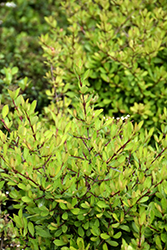It's all about ...
plants

Dwarf Walter's Viburnum
Viburnum obovatum 'Densa'
Height: 4 feet
Spread: 4 feet
Sunlight:
![]()
![]()
Hardiness Zone: 7b
Other Names: Small-leaf Viburnum, Viburnum obovatum Compacta
Brand: Monrovia
Description:
A wonderful compact, dwarf cultivar, with showy clusters of snowy white lacecap flowers in early spring followed by red fruit in summer that matures to black; adaptable, makes a great specimen or screen
Ornamental Features
Dwarf Walter's Viburnum is blanketed in stunning cymes of lightly-scented white tubular flowers with buttery yellow throats held atop the branches from late winter to early spring, which emerge from distinctive creamy white flower buds. The red fruits which fade to black over time are held in abundance in spectacular clusters from mid summer to early winter. It has dark green evergreen foliage. The small glossy oval leaves turn an outstanding coppery-bronze in the fall, which persists throughout the winter. The smooth gray bark and brick red branches add an interesting dimension to the landscape.
Landscape Attributes
Dwarf Walter's Viburnum is a multi-stemmed evergreen shrub with a more or less rounded form. Its relatively coarse texture can be used to stand it apart from other landscape plants with finer foliage.
This is a relatively low maintenance shrub, and should only be pruned after flowering to avoid removing any of the current season's flowers. It is a good choice for attracting birds and butterflies to your yard, but is not particularly attractive to deer who tend to leave it alone in favor of tastier treats. It has no significant negative characteristics.
Dwarf Walter's Viburnum is recommended for the following landscape applications;
- Accent
- Mass Planting
- Hedges/Screening
- Container Planting
Planting & Growing
Dwarf Walter's Viburnum will grow to be about 4 feet tall at maturity, with a spread of 4 feet. It tends to be a little leggy, with a typical clearance of 1 foot from the ground. It grows at a medium rate, and under ideal conditions can be expected to live for 40 years or more.
This shrub does best in full sun to partial shade. It is very adaptable to both dry and moist locations, and should do just fine under average home landscape conditions. It is not particular as to soil type or pH. It is highly tolerant of urban pollution and will even thrive in inner city environments. Consider applying a thick mulch around the root zone in winter to protect it in exposed locations or colder microclimates. This is a selected variety of a species not originally from North America.
Dwarf Walter's Viburnum makes a fine choice for the outdoor landscape, but it is also well-suited for use in outdoor pots and containers. Because of its height, it is often used as a 'thriller' in the 'spiller-thriller-filler' container combination; plant it near the center of the pot, surrounded by smaller plants and those that spill over the edges. It is even sizeable enough that it can be grown alone in a suitable container. Note that when grown in a container, it may not perform exactly as indicated on the tag - this is to be expected. Also note that when growing plants in outdoor containers and baskets, they may require more frequent waterings than they would in the yard or garden. Be aware that in our climate, most plants cannot be expected to survive the winter if left in containers outdoors, and this plant is no exception. Contact our experts for more information on how to protect it over the winter months.
This plant is not reliably hardy in our region, and certain restrictions may apply; contact the store for more information.
